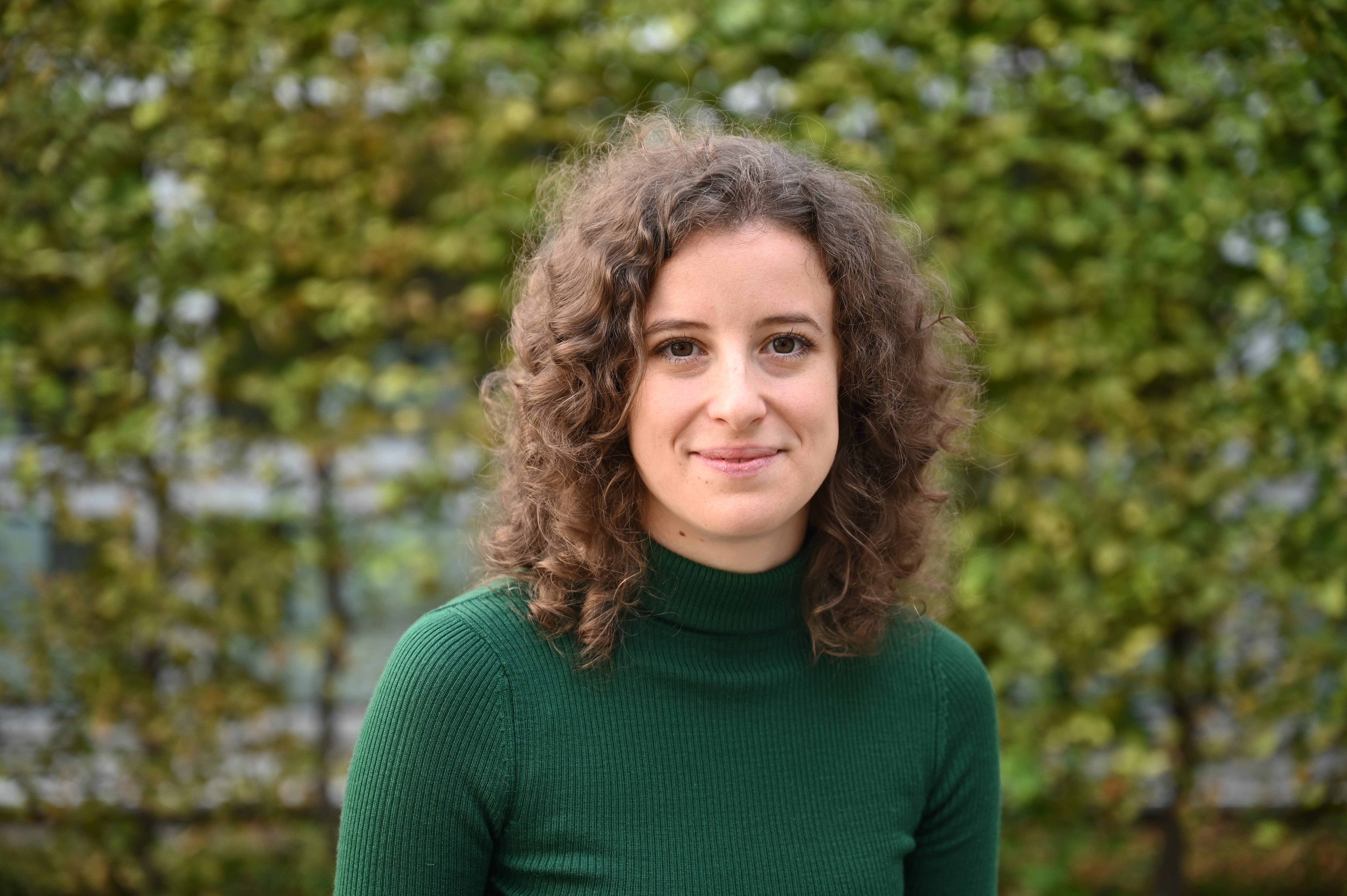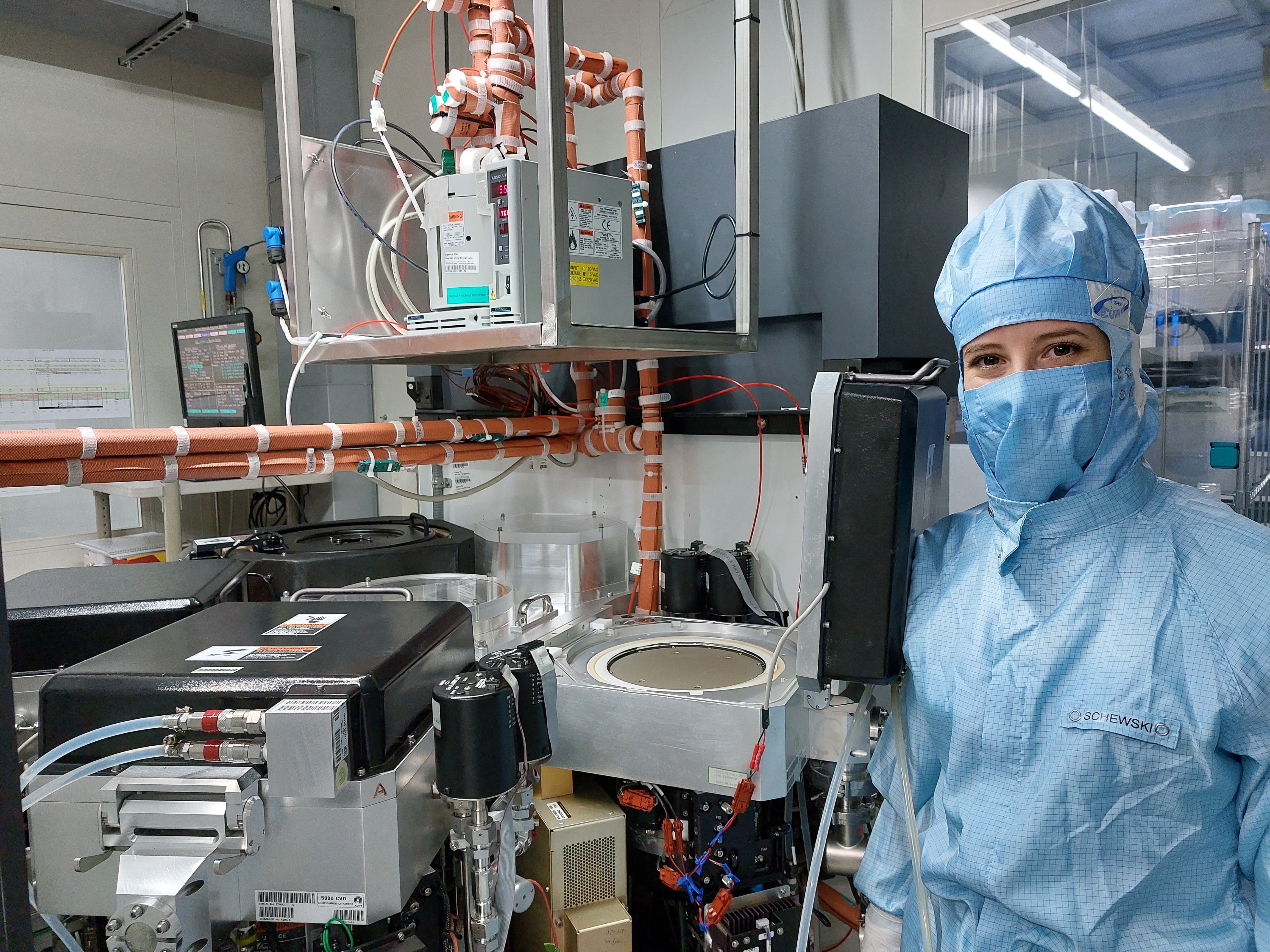"Our task is to make many qubits usable at the same time"
3D integration to pave the way for industrializing superconducting quantum hardware
Understanding complex interrelationships and delving deep into a topic – Alexandra Schewski quickly realized that she wanted to stay in research after her studies. At the Fraunhofer EMFT, she is developing processes that will enable the industrial production of superconducting quantum chips.
By Maria Poxleitner
Flags flutter in the autumn wind in front of the Fraunhofer building near Heimeranplatz in Munich. It is a clear morning and the large logo at the top of the 17-story building can be seen from afar. Alexandra Schewski walks through the spacious, modern lobby, crosses the inner courtyard and enters the Fraunhofer EMFT – the Institute for Electronic Microsystems and Solid State Technologies.
This is where the young doctoral student conducts her research. She is part of a working group that is driving the integration of superconducting hardware for quantum computers. In this context, integration means combining a large number of individual components on a chip into a functioning unit. "Of course, there's a lot of engineering behind it," explains the 27-year-old physicist. Universities have done a lot of groundwork and basic research on the fabrication of qubits. "Our task now is to produce a large number of qubits in a controlled way and to be able to use them simultaneously." One difficulty that arises: "The more qubits there are on a chip, the more difficult it becomes to route all the electrical lines to the qubits, as other qubits and their supply lines are then in the way." To solve this routing problem, the lines to the qubits have to be placed in a different plane, Alexandra continues. This is known as 3D integration, a method that is also used in classical chip technology to create more compact and powerful devices. Several sub-chips are stacked on top of each other and the individual electronic components are connected not only horizontally but also vertically. Through-silicon vias, or TSVs for short, are ideal for this purpose, explains Alexandra: "In simple terms, these are conductive connections from the top to the bottom of the chip through the chip, that is through the silicon substrate."
Adapting classical chip technology for quantum hardware
These TSVs are the focus of Alexandra's Ph.D. project. She is developing TSVs that are compatible with superconducting qubits. This is why the doctoral student can hardly rely on conventional TSV technology: "For the TSVs to be qubit-compatible, they have to be superconducting themselves. In addition, they must have low microwave loss, that is they must be designed in such a way that the microwaves used to control the qubits can, so to speak, flow through them unhindered, the physicist continues. "And then you also have very high requirements for the material itself, so you need a material with a low defect density." Even the smallest impurities in the material can disturb the sensitive qubits on the chip and lead to a loss of quantum information. This is why the young researcher spends much of her time in the clean room. Covered from head to toe, Alexandra enters the room, where filter systems keep the air as free as possible of disruptive particles. Her brown curls have disappeared under the cap of her blue overalls, and she has also put on a face mask, shoe covers, and gloves. Only her eyes remain uncovered.

Alexandra Schewski, 27
Position
Ph.D. student
Institute
Fraunhofer Institute for Electronic Microsystems and Solid State Technologies (EMFT)
SHARE
Degree
Physics
Alexandra is developing through-silicon vias that are compatible with superconducting qubits. These are superconducting connections from the top to the bottom of a chip. They are needed to place as many qubits as possible on a processor using 3D integration.

On a shelf in the far corner of the clean room are blue and black plastic boxes. Alexandra sets one of them on the table and opens the lid. Several silicon wafers, each 20 centimeters in diameter and less than a millimeter thick, are placed next to each other in slots, just like in a CD tray. Using vacuum wafer tweezers, a kind of flat suction lifter, the researcher picks up one of the thin discs and carefully removes it from the box. The polished front of the wafer is coated with a shiny metal that will be used to fabricate the qubit structures. "I process the wafers with the P5000." The physicist points to a small door on the wall, the entrance to the "P5000", as Alexandra calls the machine she mostly works on. The main part of the machine, however, is not in the clean room, but on the other side of the wall, in the adjacent gray room: "The wafers are only exposed to air in the clean room. But we can also operate the equipment from the gray room. Alexandra explains that one is allowed to be there without a cleanroom suit, and she seems quite happy not to have to work in full gear all the time.
Alexandra moves safely and quickly through the rooms. She wants to use her time as efficiently as possible, so she doesn't dawdle. Arriving at the back of the gray room, one can see the P5000 in its entirety. The system consists of four "chambers," as Alexandra calls them. Three of them look a bit like a waffle iron. In them, different materials are deposited on the wafer, the doctoral student explains. The so-called shower head is located in the lid of the three "waffle irons", while the base is formed by a susceptor, which is used to heat the wafer. "The shower head, which has many small holes, distributes the material evenly over the wafer. The heat is necessary for the chemical process to take place that deposits the material onto the wafer," explains the physicist. A fourth chamber, which looks slightly different, can be used to etch structures into the metal layer. The young researcher is very familiar with the machine. Every move fits. Alexandra goes to the control panel and brings one of the chambers into the wafer lift position. The susceptor moves down, exposing four pins. A robotic arm with a flat end then moves under the wafer, much like a spatula, lifting it slightly and moving it from chamber to chamber. Alexandra adds: "While I'm processing a wafer in the machine, it stays closed. I can control everything from the outside."
Benefit from professional exchange among doctoral students
To make TSVs, cylindrical holes are first etched through the silicon substrate. To create a superconducting connection from the top to the bottom of the chip, Alexandra has to deposit a metallic film on the inner wall of the hole. The proper metallization of these cylindrical holes is the focus of her work: "This metal film is very, very thin. It is very challenging to get it everywhere because this hole has a small opening and a large depth.” It is also very difficult to influence the properties of the metal film because, for example, the gas dynamics in the hole are completely different from those on the surface of the chip, which has an extreme influence on the growth of the metal film, the researcher continues. One of the first challenges in her Ph.D. was to make the metal film superconducting. That didn't work out for a while, Alexandra recalls, but the professional exchange during the Benasque Spring School in spring 2023 finally helped her. She was able to pick up a few tips and tricks there. The event in the small, remote mountain village of Benasque in the Pyrenees, which was attended by doctoral students and postdocs from many different countries, lasted ten days, says the young researcher. Everything revolved around superconducting qubits. Having only entered the field of quantum computing with her Ph.D., Alexandra greatly appreciated the opportunity to delve deeper into the fundamental questions of the fabrication of superconducting qubits and the physics behind it. In particular, the intensive exchange with other doctoral students, all of them working on superconducting qubits, helped her tremendously from a technical perspective. "It was definitely a highlight of the first year of my Ph.D."
When Alexandra describes her "daily business", she talks about process development: "I want to find out which process parameters influence my result." The metallic film for her TSVs must have certain properties, and she now varies process parameters such as pressure or temperature to see how that affects the result. Although Alexandra's focus is on process development for the production of superconducting TSVs, the overall process development must always be kept in mind: "The individual processes that go into producing a superconducting chip must all be compatible with each other, and that is a huge challenge." The most critical structure is the Josephson junction, Alexandra points out – an electronic element, only a few hundred nanometers in size, that is, in a sense, the heart of a superconducting qubit. If, for example, the qubit structures are etched first and the holes for the TSVs are etched afterwards, there is no guarantee that the etching of the holes will not change the Josephson junctions again, explains the researcher. There are many different ways to arrange the sequence of individual processes, and there is always the question of what happens to the various elements on the chip, she summarizes.
Vacuuming is also part of the job
After studying physics in Erlangen, Alexandra made a conscious decision to pursue a Ph.D.: "Understanding interrelationships and delving deeper into a topic is something I really enjoy." However, day-to-day work does not always consist of puzzling over and thinking through complex processes. There is no getting around maintenance work in process development, says the doctoral student. Recently, she had to clean the inside of the P5000 because material fluff had come off during a process and was spread all over the interior. She first used a special cleanroom vacuum cleaner for this. Alexandra laughs: "This vacuum cleaner is awesome." She then had to wipe out every corner of the machine with special cloths. "That was very time consuming." Sometimes, however, maintenance problems arise that are less obvious than a dirty machine and require a certain level of creativity. "I then always have lots of ideas and try everything one after the other until everything works again. I hope I never get into a situation where I no longer know what to try," says the young researcher with a laugh.
But even when this is the case, Alexandra can count on the exchange with her colleagues, whom she appreciates very much. In fact, she appreciates them so much that she is willing to meet them at the bouldering hall once a week at seven in the morning before work. She smiles: "I wouldn't describe myself as a typical early riser, but I really enjoy doing it and if you have an appointment...". In addition to the close exchange with her colleagues, she also finds it inspiring to be part of the larger MQV community: "As an individual, you sometimes lose sight of the big picture quite quickly. What I like about MQV is that we have so many project partners covering a very broad area of quantum computing." By exchanging ideas with other research groups, even small intermediate goals that one achieves can be placed in a larger context.
Published 28 February 2024; Interview 23 October 2023